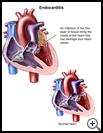
Heart Infection (Endocarditis)
________________________________________________________________________
KEY POINTS
- Endocarditis is an infection of the thin layer of tissue lining the inside of the heart caused by bacteria, yeast, or fungi.
- You may need to stay at the hospital for a while. You will take antibiotics for several weeks. You may need surgery.
- Follow the full course of treatment prescribed by your healthcare provider. Ask your provider how to take care of yourself at home. Ask your healthcare provider if you should take an antibiotic before any kind of dental work or surgery.
________________________________________________________________________
What is endocarditis?
Endocarditis is an infection of the thin layer of tissue lining the inside of the heart. The infection can also damage your heart valves. If a heart valve is badly damaged, your heart has to work harder and may get bigger. You may not be able to exercise as much as you used to. The infection could travel from the heart to other parts of the body, causing other problems, such as stroke or damage to the kidneys.
What is the cause?
The infection may be caused by bacteria, yeast, or fungi. Endocarditis usually is caused by an infection that starts in another part of the body and spreads through the bloodstream to the heart. This may happen if you have:
- An infected wound
- A mouth infection
- Surgery or other procedures, bladder catheter, or an IV that gets infected
You are more at risk for endocarditis if you have:
- Heart valve damage from rheumatic fever, or other heart valve problems
- Some types of birth defects in the heart
- An artificial heart valve
Your risk is also higher if you have had endocarditis before or if you share needles to inject drugs.
What are the symptoms?
Symptoms may include:
- Fever
- Sweats
- Chills
- Loss of appetite
- Feeling tired
- Weight loss
- Joint and muscle pain
At first, the infection may be mistaken for the flu, but the symptoms usually get worse with time.
How is it diagnosed?
Your healthcare provider will ask about your symptoms and medical history and examine you. Tests may include
- Echocardiogram, which uses sound waves (ultrasound) to look at your heart and check how well the valves are working The echocardiogram may be done using a small tube passed down your throat to give the clearest picture of the heart and valves.
- Blood tests
How is it treated?
You may need to stay at the hospital for a while. You will take antibiotics for several weeks.
You may need surgery if the antibiotics cannot get rid of the infection or if one of your heart valves is badly damaged. If you have an artificial heart valve and get endocarditis, the infected valve is usually replaced with a new one.
How can I take care of myself?
Follow the full course of treatment prescribed by your healthcare provider. Ask your provider:
- How and when you will get your test results
- How long it will take to recover
- If there are activities you should avoid and when you can return to your normal activities
- How to take care of yourself at home
- What symptoms or problems you should watch for and what to do if you have them
Make sure you know when you should come back for a checkup. Keep all appointments for provider visits or tests.
How can I help prevent endocarditis?
Although rare, damaged, abnormal, or artificial valves are more likely to get infected by bacteria. Ask your healthcare provider if you should take an antibiotic before any kind of dental work or surgery. This includes having your teeth cleaned or procedures involving the bladder, vagina, or rectum.

